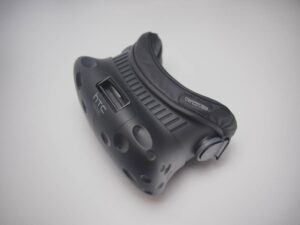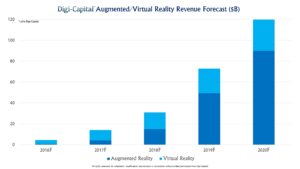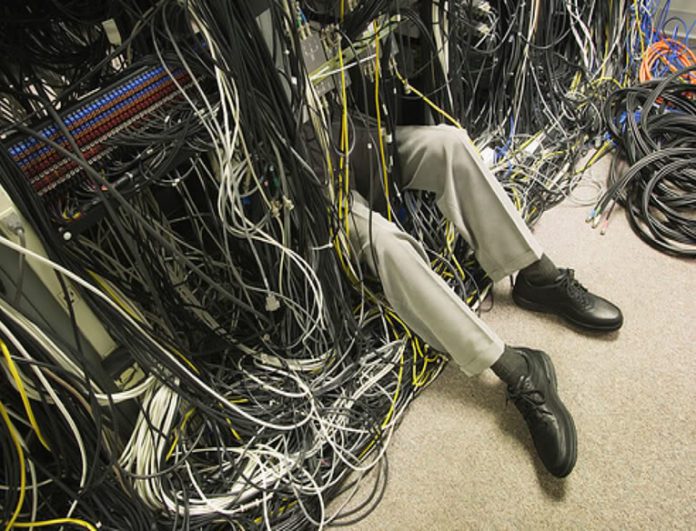Any time that a person brings up using virtual reality for working out, the negative comments immediately begin:
“Sweat in a heavy VR headset? LOL, that’s disgusting!”
“OMG! You’ll be tripping all over the wire!”
“You’ll get nauseous after a few minutes of jumping around. I’m dizzy just thinking about it!”
Some of their points are valid, but only if you can’t see where VR hardware and software is going in the very near future. VR and AR will be a huge force in the fitness industry and the naysayer comments will be forgotten. Here are the biggest concerns today and how they will be solved tomorrow.
1. Current headsets are too big and bulky to wear while working out.
Many sports require you to wear a mask or helmet like skiing, cycling, motocross, hockey, swimming, and of course, football. While it may be more comfortable to not wear a football helmet while you play, it’s not recommended. Athletes are used to wearing masks and helmets as part of their gear.

Today’s HMDs are not as big as many other sports helmets, but they are still not the most comfortable thing to wear while jumping and moving around. As we all know, technology continues to get smaller and smaller as it progresses, and the evolution of VR over the previous decades is showing no sign of slowing. The VR/AR headsets of tomorrow will be as small as your sunglasses or goggles, and someday you’ll get the features from your contact lenses.
The next few generations of HMDs from the major players will surely be smaller, lighter, and more comfortable, paving the way for easier fitness applications.
2. Sweating in your HMD is disgusting and unsanitary.
Sweating inside your Rift or Vive, especially one that you share with others, isn’t very appealing. Luckily, companies like VR Cover have released versions of their HMD covers that are made to sweat in that can be easily cleaned with a few antibacterial wipes. You could also use the sweat proof cover for fitness and put the regular covers back on for other applications.

If you are very sensitive to germs, you could buy a VR cover for each person that will use the device.
3. Moving quickly in VR can cause extreme motion sickness.
Some people are more sensitive to VR sickness than others, suggesting a genetic component. Others are less susceptible, but a bad VR experience can create knots in even the strongest stomachs around.

As VR headsets and software improve, latency gets better and sickness goes down. Also, companies are learning which types of movements in VR cause the most sickness and are finding ways around them. Strafing, quick forward movements, and laggy environments appear to cause the most issues, and are easily avoided with proper design. Fitness applications may be limited to certain types of environments, perhaps staying on a stationary platform instead of moving through a world, or teleporting to areas rather than traveling by walking or riding in a car.
It may just take a little time for people to get used to VR for the symptoms to go away. It turns out that people that get VR sickness can lessen or eliminate the effects with practice.
There are ways to develop experiences that will be comfortable for most or all users and testing the app with all types of people will help find the best methods.
4. The wires are always in your way.
Even when playing seated experiences, the wire is always there. Getting it situated and out of the way becomes part of our everyday VR life. Games with a lot of room-scale movement (especially twisting and 360 degree movements) cause the wire to tangle around our legs or uncomfortably around our neck. Mobile experiences like the Samsung Gear do not have wires, but they are 3DOF at best, lower quality (which are more likely to create VR sickness), and not conducive to workout experiences.
For now.
For anybody following the progress of VR technology, it’s obvious that there is serious investment into creating high-end, untethered experiences. The mobile and PC-based VR headsets will slowly merge until mobile and high quality become one and the same. And it will probably happen sooner than we expect, opening the way for fitness games and apps that are currently not possible.
5. There are not enough people with VR headsets at home for companies to target and sell to.
Just give it a little more time.

6. You can’t get a full functional workout with an HMD and two hand controllers.
Try to do a pushup while holding your hand controllers. Not very easy.
But that’s changing. Valve is opening up free access to their SteamVR SDK and Lighthouse technology to allow companies to create all sorts of peripherals that can be used inside games and apps. Oculus rumors suggest they plan the same thing.
Wristwraps, feet tracking, and more will likely be available within a year. Black Box VR is working to create fitness versions of these peripherals that are made specifically for working out. Ab wheels, smart dumbbells, resistance bands, yoga mats, and much more won’t be far behind, bringing a whole new tech fitness aisle to your local Target.
7. Not everybody has room for a room-scale VR system in their little urban apartment.
To workout inside VR, you need a good sized area for movement. Not everybody will have that much room and so they won’t be able to participate.
VR fitness facilities will fill the gap with high-end VR hardware and software that will be available for use just like that fancy treadmill or tanning bed at your local gym. Small boutique gyms will bring the VR fitness revolution to your local neighborhood. It’s an arcade where the more quarters you pump in, the more you get pumped up.
Conclusion
These limitations are easily worked around or will be in the very near future. Companies and trainers that work now to be ready for the inevitable VR fitness explosion will pave the way for a whole new world that will benefit the fitness scene in ways that are clearly revolutionary. No more Zumba. No more boring DVD workouts. No more crowded weight rooms. Build your health and fitness in a virtual world and when you remove the headset to bring yourself back to reality, you’ll wonder how you ever got along without it.
-Ryan DeLuca
Have you got any insider tips about the world of VR and fitness that you think we need to know? Make a comment below and our editors will get back to you ASAP!












Awwwww yeeeea!